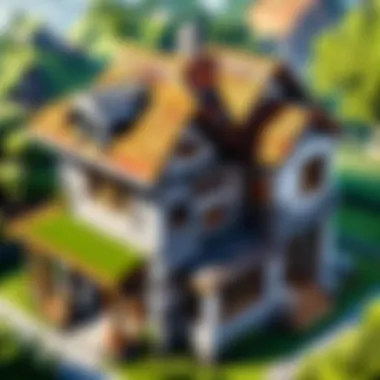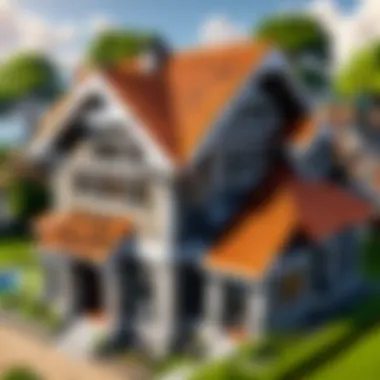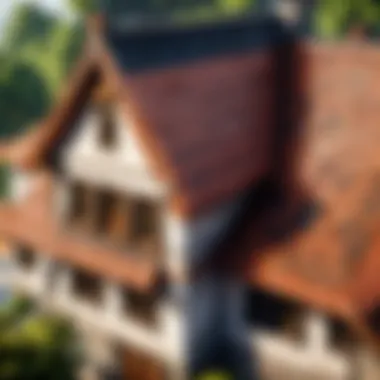Discovering the Wide Array of Roof Styles Seen on Residential Homes


When delving into the realm of residential roofing, it becomes apparent that the variety of roof styles on houses is truly extensive. From the timeless appeal of traditional designs to the sleek aesthetics of modern roofing options, each type possesses its own unique characteristics and benefits that contribute to the overall look and functionality of a property.
Traditional Roof Styles
One of the enduring charms of residential architecture lies in the traditional roof styles that have stood the test of time. Gable roofs, with their classic triangular shape, are among the most common types found on houses. Their pitched design facilitates water drainage, making them a practical choice for regions with abundant rainfall. Additionally, hipped roofs boast a more complex structure, with all sides sloping downwards, providing increased stability and durability against strong winds.
Modern Roof Designs
In contrast to their traditional counterparts, modern roof designs often feature flat or low-pitched roofs that exude a minimalist and contemporary vibe. Flat roofs, with their simple, horizontal planes, offer a sleek and stylish aesthetic popular in modern architectural trends. Shed roofs, characterized by their single-sloping surface, are another modern option that provides architectural interest while optimizing interior space utilization. Furthermore, butterfly roofs present a unique architectural statement with their distinctive V shape that captures rainwater for eco-friendly purposes.
Roofing Materials and Durability
The choice of roofing materials significantly impacts the durability and longevity of a roof. Common materials such as asphalt shingles, metal roofing, clay tiles, and slate offer varying degrees of durability, weather resistance, and aesthetic appeal. Asphalt shingles remain a popular choice for their affordability and versatility, adapting well to different housing styles. On the other hand, metal roofing offers exceptional durability and low maintenance requirements, making it a sustainable option for eco-conscious homeowners. Clay tiles and slate, though considered more costly, deliver unparalleled durability and aesthetic charm, adding a touch of elegance to any property.
Conclusion
Introduction
Roofs are one of the most crucial elements of a house, providing protection, insulation, and architectural character. In this comprehensive guide, we will navigate through the diverse landscape of roofing styles found on residential properties. From timeless traditional designs to sleek modern concepts, understanding the various types of roofs is indispensable for any homeowner or enthusiast of architectural diversity.
To begin our exploration, we will unravel the essence of classical roof styles, such as the Gable Roof, Hip Roof, Mansard Roof, and Gambrel Roof. Each style holds its unique characteristics in terms of aesthetics and practicality, shaping the overall look and functionality of a residence. Moving forward, we will delve into the realm of modern roof designs, including the Flat Roof, Butterfly Roof, Shed Roof, and Skillion Roof, showcasing how contemporary architecture has pushed the boundaries of creativity and functionality in roofing.
As we venture even further, we will uncover the lesser-known, yet intriguing uncommon roofing types like Green Roofs, Sawtooth Roofs, Pyramid Roofs, and Dome Roofs. These unconventional styles present fresh perspectives on energy efficiency, visual appeal, and environmental sustainability in roofing practices. Exploring these unconventional designs will enlighten readers on the diverse possibilities in architectural expression through roofing.
Moreover, we will scrutinize the significance of selecting the right roofing materials for durability and longevity. From the popular Asphalt Shingles to the resilient Metal Roofing, elegant Clay Tiles to luxurious Slate Roofing, each material choice comes with its own set of advantages and considerations. Understanding the properties and characteristics of these materials is essential for making informed decisions when it comes to roof construction and maintenance.
Lastly, we will investigate the environmental impact of roofing choices, emphasizing the importance of energy-efficient options, sustainable roofing materials, cool roof technologies, and the various benefits of green roofs. By examining the ecological footprint of different roofing styles and materials, readers will gain insights into how their choices can contribute to a more sustainable and eco-friendly living environment.
In essence, this article serves as a comprehensive roadmap to the intricate world of residential roofing, illuminating the unique features, pros and cons, and aesthetic considerations inherent in each type of roof. By the end of this exploration, readers will have a profound understanding of the role roofs play in shaping the identity and functionality of a house, empowering them to make informed decisions when it comes to their own roofing needs.
Traditional Roof Styles


In this extensive exploration of the various types of roofs found on houses, the section dedicated to Traditional Roof Styles plays a crucial role. Traditional roof styles hold a significant place in the architectural landscape, reflecting historical preferences, regional variations, and timeless design principles. These classic roof designs not only exhibit aesthetic appeal but also offer practical advantages in terms of weather resistance, ventilation, and insulation. Understanding Traditional Roof Styles is essential for homeowners, architects, and roofing professionals to make informed decisions based on both heritage and functionality.
Gable Roof
The Gable Roof is a quintessential traditional roof style characterized by its triangular shape and two sloping sides that meet at the ridge. This design is iconic for its simplicity and efficiency in shedding water and snow, making it a popular choice in regions prone to inclement weather. The steep pitch of Gable Roofs allows for effective rainwater drainage and provides ample attic space for storage or additional living areas. However, proper maintenance is crucial to prevent structural issues related to wind uplift and snow accumulation on the gable ends.
Hip Roof
The Hip Roof is another traditional roof style known for its four sloping sides, with each side forming a gentle slope without vertical ends. This design offers excellent stability and resistance to strong winds, making it a preferred option in hurricane-prone areas. Hip Roofs provide a more symmetrical appearance compared to Gable Roofs and are adaptable to various architectural styles, from colonial to modern. With proper bracing and reinforcement, a Hip Roof can enhance energy efficiency by promoting proper ventilation and reducing heat gain in the attic space.
Mansard Roof
Among the traditional roof styles, the Mansard Roof stands out for its distinctive profile featuring four slopes with two steeper lower slopes and two less steep upper slopes. This French-inspired design adds a touch of elegance and grandeur to Victorian and Second Empire-style homes. Mansard Roofs create additional living space in the form of attic rooms or garrets, maximizing the functional use of the top floor. Despite its aesthetic appeal, Mansard Roofs require regular inspection and maintenance to prevent water infiltration and damage to the steep slopes.
Gambrel Roof
The Gambrel Roof, also known as a barn roof, combines the features of a gable roof with a Mansard roof, featuring two distinct slopes on each side. This design offers increased headroom and living space in the attic while maintaining a classic and charming appearance. Gambrel Roofs are commonly found in colonial and Dutch colonial architectural styles, evoking a sense of nostalgia and heritage. These roofs require proper waterproofing and ventilation to prevent moisture buildup and wood rot in the upper areas. Understanding the unique characteristics and considerations of Gambrel Roofs is essential for preserving their structural integrity and visual appeal.
Modern Roof Designs
One significant aspect of modern roof designs is their emphasis on minimalism and sleek aesthetics. Unlike traditional roof styles, the modern designs often feature clean lines, flat surfaces, and a simplistic overall appearance. This minimalist approach not only adds a touch of sophistication to the property but also contributes to a more streamlined and modern look. Additionally, modern roofs are known for their versatility, allowing for creative customization and architectural experimentation to suit varying preferences and structural requirements.
Moreover, the incorporation of advanced materials and construction techniques in modern roof designs enhances durability and longevity. Materials such as fiberglass, PVC, and modified bitumen offer superior strength and weather resistance, ensuring that the roof can withstand harsh elements and environmental factors. This durability is particularly advantageous for homeowners seeking a long-term roofing solution that requires minimal maintenance and upkeep.
Another key benefit of modern roof designs is their focus on energy efficiency and sustainability. Many contemporary roofing options utilize eco-friendly materials and innovative technologies to minimize energy consumption and reduce environmental impact. Features like solar panels, green roofs, and cool roof coatings are commonly integrated into modern designs to promote energy conservation and enhance the overall eco-friendliness of the property.
Flat Roof
Flat roofs are a popular choice in modern architecture, offering a unique and contemporary aesthetic to residential properties. Unlike traditional sloped roofs, flat roofs feature a horizontal or nearly flat orientation, creating a clean and minimalist look that complements modern design principles. The design simplicity of flat roofs allows for versatile[continue writing text as required.]
Butterfly Roof


Butterfly roofs are distinctive modern roof designs characterized by their innovative form and striking appearance. This roof style derives its name from its resemblance to the outstretched wings of a butterfly, creating a visually captivating[continue writing text as required.]
Shed Roof
Shed roofs, also known as skillion roofs, are a contemporary roof design that offers a practical and stylish solution for residential properties. Featuring a single slope with a noticeable pitch, shed roofs provide efficient water[continue writing text as required.]
Skillion Roof
Skillion roofs, or mono-pitched roofs, are a popular choice for modern homes seeking a sleek and asymmetrical architectural aesthetic. These roof designs consist of a single flat surface with a noticeable slope, creating a striking[continue writing text as required.]
Uncommon Roofing Types
In this exceptional segment of our exploration into the various roof types on houses, we shift our focus to the often overlooked category of Uncommon Roofing Types. While traditional and modern designs dominate the housing landscape, these unique roof styles bring a touch of novelty and distinction to architectural aesthetics. The inclusion of Uncommon Roofing Types in this article serves to broaden readers' horizons and inspire a deep appreciation for the diverse possibilities in roof construction and design. By shedding light on Green Roofs, Sawtooth Roofs, Pyramid Roofs, and Dome Roofs, we aim to elucidate their individual characteristics, benefits, and considerations that set them apart from more mainstream options.
Green Roof
One of the unconventional yet environmentally friendly roofing styles discussed here is the Green Roof. This eco-conscious approach involves covering the roof with a layer of vegetation, such as grass, plants, or even trees, providing insulation, absorbing rainwater, and reducing urban heat island effects. Green Roofs not only enhance thermal performance and air quality but also contribute to biodiversity and green space conservation in urban areas. By exploring the concept of Green Roofs in detail, readers will grasp the significance of sustainable building practices and the positive impact they can have on the environment and overall well-being.
Sawtooth Roof
Moving on to the Sawtooth Roof, we encounter a distinct design characterized by a series of parallel ridges with alternating vertical and sloping facets. Originating from industrial architecture, the Sawtooth Roof offers excellent natural lighting and ventilation, making it a popular choice for factories and warehouses. Its unique shape allows for uniform illumination throughout the space, reducing the need for artificial lighting and improving energy efficiency. Through a thorough examination of the Sawtooth Roof, readers will uncover its functional advantages, visual appeal, and considerations for integrating this unconventional style into residential roof design.
Pyramid Roof
The Pyramid Roof stands out for its iconic pyramid shape, reminiscent of ancient architectural marvels like the Egyptian pyramids. This striking form not only adds a touch of grandeur to a building but also offers structural integrity and efficient rainwater drainage. With steeply sloping sides converging at a central point, the Pyramid Roof provides excellent stability and water-shedding capabilities, ideal for regions with heavy precipitation. By delving into the features and benefits of the Pyramid Roof, readers will gain insight into its timeless allure, practical advantages, and potential applications in modern construction.
Dome Roof
Lastly, we explore the architectural elegance of the Dome Roof, known for its curved or rounded shape that creates a spacious and visually captivating interior. Domes have been prominent in various cultures and periods, symbolizing strength, harmony, and unity. Modern interpretations of the Dome Roof combine traditional craftsmanship with contemporary materials and technologies, offering a blend of heritage and innovation. By uncovering the enduring appeal and structural efficiency of Dome Roofs, readers will appreciate the artistry, symbolism, and functional benefits that define this exceptional roof style.
Roofing Materials and Durability


Roofing materials and durability play a significant role in the overall construction and longevity of a house. When selecting roofing materials, various elements need to be considered to ensure the roof's quality, performance, and aesthetic appeal. The durability of the roof is crucial as it directly impacts the maintenance costs and lifespan of the property. By understanding the different types of roofing materials available and their durability, homeowners can make informed decisions that align with their preferences and budget. Factors such as weather resistance, insulation properties, and eco-friendliness should be taken into account when choosing the right roofing material for a house.
Asphalt Shingles
Asphalt shingles are one of the most popular roofing materials due to their affordability, versatility, and ease of installation. They are available in a variety of colors and styles, making them suitable for different architectural designs. Asphalt shingles are durable, providing excellent protection against the elements and offering decent insulation properties. However, they may require regular maintenance and replacement over time, especially in areas with extreme weather conditions. Homeowners looking for a cost-effective roofing option with a wide range of choices often opt for asphalt shingles.
Metal Roofing
Metal roofing has gained popularity in recent years due to its durability, longevity, and eco-friendly properties. Metal roofs are highly resistant to fire, mildew, insects, and rot, making them a low-maintenance option for homeowners. They have a long lifespan compared to other roofing materials and are recyclable, reducing environmental impact. While metal roofing may have a higher initial cost, the long-term benefits outweigh the investment for many homeowners looking for a sustainable and durable roofing solution.
Clay Tiles
Clay tiles are known for their classic and timeless appearance, adding character and charm to houses. These roofing materials are durable, weather-resistant, and energy-efficient, making them a popular choice in many regions. Clay tiles are available in various shapes, sizes, and colors, allowing homeowners to customize their roofs according to their preferences. While clay tiles offer excellent insulation and durability, they may be heavier than other roofing materials, requiring additional structural support during installation. Homeowners looking for a long-lasting and aesthetically pleasing roofing option often opt for clay tiles.
Slate Roofing
Slate roofing is renowned for its natural beauty, durability, and sustainability. Slate roofs can last for decades without requiring much maintenance, making them a cost-effective long-term investment. They are fire-resistant, environmentally friendly, and add a touch of elegance to any property. While slate roofing is one of the more expensive options, its unparalleled durability and aesthetic appeal make it a preferred choice for homeowners seeking a high-end and timeless roofing solution.
Environmental Impact of Roofing Choices
When considering the various types of roofs found on houses, it's crucial to delve into their environmental impact. The choice of roofing material can significantly affect the sustainability and energy efficiency of a building. Opting for eco-friendly roofing options not only promotes environmental consciousness but also can lead to long-term cost savings. Green initiatives in construction have made energy-efficient roofing choices more accessible, encouraging homeowners to make environmentally responsible decisions when it comes to their roofs.
Energy-Efficient Options
Energy-efficient roofing options are gaining popularity due to their capacity to reduce energy consumption and lower utility bills. Materials such as cool roofs, which reflect sunlight and heat away from the building, can help maintain cooler indoor temperatures during hot weather. This reduces the need for excessive air conditioning, thereby decreasing energy usage. Additionally, solar panels integrated into the roofing system can harness renewable energy sources, further offsetting electricity consumption. Embracing energy-efficient options not only benefits the environment but also enhances the overall sustainability of a property.
Sustainable Roofing Materials
Sustainable roofing materials are designed to minimize environmental impact while offering durability and functionality. Materials like recycled metal, reclaimed wood, or sustainably sourced clay tiles are popular choices for eco-conscious homeowners. These options not only reduce waste but also contribute to the conservation of natural resources. Implementing sustainable roofing materials in construction projects aligns with a broader push towards green building practices, fostering a more environmentally friendly approach to infrastructure development.
Cool Roofs
Cool roofs play a vital role in reducing heat absorption and managing indoor temperatures. By reflecting sunlight and heat, cool roofs help lower cooling costs, particularly in regions with warmer climates. The use of reflective coatings or light-colored materials enhances solar reflectance, reducing the need for constant air conditioning. Cool roofs can mitigate the urban heat island effect, promote energy savings, and improve overall comfort within buildings, making them a practical and environmentally responsible roofing option.
Green Roof Benefits
Green roofs, also known as living roofs, offer a range of environmental benefits that extend beyond traditional roofing systems. By incorporating vegetation and greenery into the roof space, these roofs aid in insulating buildings, improving air quality, and absorbing rainwater. Green roofs help reduce stormwater runoff, combat air pollution, and create green spaces in urban settings. Furthermore, they contribute to biodiversity and habitat preservation, showcasing the harmonious integration of architecture and nature.



